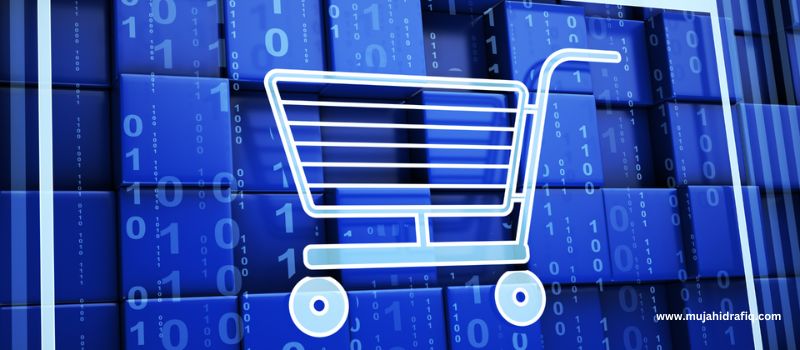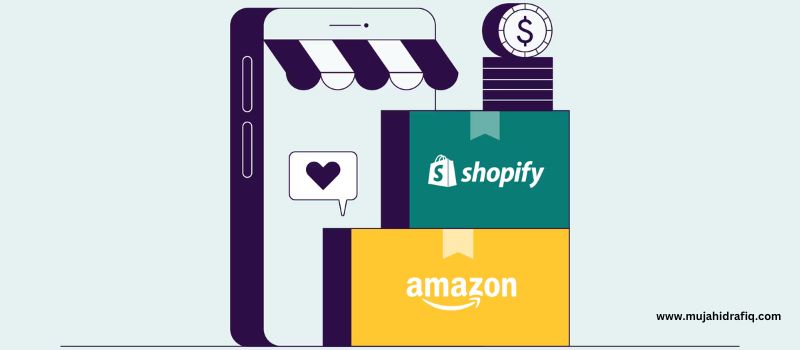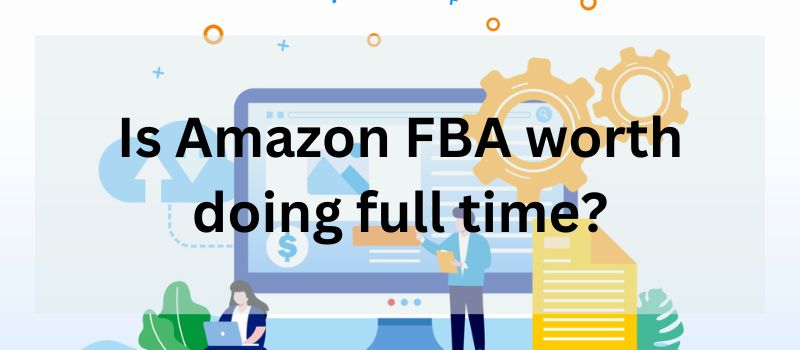Starting an online business can be an exciting yet daunting endeavor. As you conduct your research, you’ll inevitably come across two incredibly popular ecommerce platforms, Shopify and Amazon FBA.
But how do you know which one is better suited for your needs?
Starting an online business is no small feat these days. As an aspiring ecommerce expert, you likely grapple with countless questions around platforms, logistics, branding, and more.
I’ve been there myself. When I first dreamed of launching a thriving virtual storefront, I overwhelmed myself researching the tools of the trade. But after years building on both Shopify and Amazon FBA, So, As an amazon fba expert mujahid rafiq I’m here to lend some hard-won wisdom.
As an amazon fba expert mujahid rafiq have built online stores on both Shopify or Amazon FBA, so I want to share my experiences to help guide you. Basically, let’s break down the core differences between these two juggernauts to see which model aligns more closely with your goals and capabilities.

Contents
- 1 Shopify or Amazon FBA (or any other online business)?
- 2 Difference between Shopify or Amazon FBA
- 3 Overview of Shopify and Amazon FBA Business Models
- 4 Startup Costs and Inventory Considerations
- 5 Platform Tools and Seller Support
- 6 Sales Channels and Marketing Capabilities
- 7 Scalability and Growth Potential
- 8 Final Considerations in Choosing an Ecommerce Model
- 9 FAQs:
- 9.1 Q1: What are the fees for Shopify and Amazon FBA?
- 9.2 Q2: Does Shopify have more startup costs than Amazon?
- 9.3 Q3: Is Shopify or Amazon better for new sellers?
- 9.4 Q4: Does selling on Amazon require a Shopify store?
- 9.5 Q5: Can I sell on both Shopify and Amazon together?
- 9.6 Q6: What gets better customer support, Shopify or Amazon FBA?
- 10 Conclusion:
Shopify or Amazon FBA (or any other online business)?
Both Shopify and Fulfillment By Amazon fba represent viable ecommerce models. It just depends whether you prioritize creative freedom or plugging into a proven marketplace. As your resident ecommerce expert in both worlds.
I often guide aspiring entrepreneurs through these options. With Shopify you retain flexibility, though Amazon’s built-in audience skips the tough traffic-building phase. Evaluate your appetite for branding versus faster revenue, then leverage my VA services to hit the ground running!
Difference between Shopify or Amazon FBA
| Factor | Shopify | Amazon FBA |
|---|---|---|
| Startup Costs | $29+ per month for basic subscription, plus costs for themes, hardware, and tools. Can range from $100 to over $1000+ | $40 per month for Individual Seller account. Storage and fulfillment fees also apply, which vary by product |
| Brand Ownership | Full control and ownership over brand, products, and customer data | Don’t own brand relationship or customer data |
| Order Fulfillment | Merchant handles storage, packing, and shipping. Costs vary based on operations. | Outsourced to Amazon. Fees typically 15-20% of sales. |
| Marketing / Audience Reach | Merchant builds own marketing campaigns to drive traffic. No native audience. | Instant access to Amazon’s site traffic and buyers. |
| Tools & Analytics | Robust app ecosystem and integrations. Business analytics provided. | Built-in inventory and order management tools. Sales data analytics centralized. |
| Scalability Potential | High ceiling for growth over time by adding store capabilities. | Growth also possible but may require expanding to other sales channels. |
| Customer Support | 24/7 live support and large knowledge base resources. | Available but mixed seller feedback on reliability. |
Overview of Shopify and Amazon FBA Business Models
Before diving into the details, you need to understand what Shopify and FBA represent as businesses.
What is Shopify?
Shopify is an ecommerce platform that provides the tools and functionality needed to build your own online storefront. This includes themes, payment processing, shipping integrations, and more.
With Shopify, you create your own brand and website to sell your products or services. As an ecommerce expert you control and customize all aspects of your online store. Though you need some technical know-how. Shopify handles the backend so you can focus on sales and marketing.
The main benefit of Shopify is you own your brand and customers. However, you also take on more responsibility for driving traffic and conversions.

What is Amazon FBA?
FBA stands for Fulfillment by Amazon, and represents Amazon’s order fulfillment services. With Amazon FBA, you sell your products directly via Amazon’s gigantic ecommerce marketplace.
So rather than creating your own site, you list your items in Amazon’s catalog. When orders come in, you ship your inventory to Amazon’s warehouses and they handle storage, packing, and shipping.
The main advantage here is you instantly gain access to Amazon’s hundreds of millions of buyers. As an amazon fba expert you also offload fulfillment operations to Amazon. The tradeoff is you don’t own the customer relationship.
Key Differences Between Shopify and FBA
To recap, Shopify equips you to create your own online storefront and brand. Amazon FBA offers an established marketplace where you can sell products directly to Amazon customers.
With Shopify, you manage branding, marketing, traffic generation, and order fulfillment yourself.
Amazon FBA handles fulfillment for you but you don’t own the buying experience or customer relationship.
Now let’s explore some practical considerations in choosing between Shopify or Amazon FBA (or any other online business)?

Startup Costs and Inventory Considerations
Setting up any business involves some seed money and Shopify and Amazon FBA are no exceptions. So you should understand the initial investments needed plus ongoing inventory costs.
Initial Investment Needed
A Shopify subscription starts from $29 per month for their basic Shopify plan. This helps you get an online store up and running without huge startup costs.
You will also need a theme, apps, hardware, and tools which can range from $100 to $1000+ depending on complexity.
For Amazon, as an amazon fba expert officially you need an Amazon Seller account which runs $40 per month. However to gain FBA privileges, most advise enrolling in the Professional plan for $40 monthly.
There are add-on costs for storage and fulfillment fees too which vary by product. Overall, Shopify offers lower startup costs though admins fees applying with FBA.
Ongoing Inventory Costs
In terms of handling inventory, if you operate your own fulfillment with Shopify, costs remain low presuming you store at home or lease a small warehouse space. Shipping rates apply when sending orders of course.
With FBA however, Amazon charges for storing inventory in their warehouses plus fulfillment and shipping fees per order. These costs typically range 15-20% of sales. Storage and processing during less busy periods also incur fees.
So Amazon FBA provides convenience at the expense of higher fees through their fulfillment services. With Shopify, you take on fulfillment but costs are predictable versus variable with FBA.
Sourcing and Managing Products
Product sourcing and relationships with suppliers may also steer you towards one model. Owners with an existing or emerging product line may prefer Shopify to retain control over branding and manufacturing partnerships.
Turnkey dropshipping through platforms like Oberlo makes fulfillment easier for certain Shopify businesses. However, Amazon’s scale often enables better wholesale pricing to maximize margins.
It depends whether you want to be more involved in product development or take a hands-off approach and let Amazon reduce the sourcing heavy lifting.
Platform Tools and Seller Support
Now let’s explore the tools and functionality provided within Shopify and Amazon FBA to facilitate sales growth. Understanding the dashboard and analytics available will shed light on support systems central to an ecommerce operation.
Shopify Apps and Integrations
The core Shopify software helps run web hosting, payments, shipping, etc. But the app store offers thousands of add-ons for marketing, accounting, and automation to enhance functionality. Zapier and Klaviyo are commonly integrated.
Leaning on these platforms somewhat offsets Shopify’s steeper learning curve for beginners. While Shopify isn’t inherently user-friendly, integrations bridge certain feature gaps nicely.
Amazon Seller Tools and Account Management
Amazon makes inventory, advertising, and order management intrinsic through FBA and centralized reporting dashboards. Built-in analytics provide insight into sales, traffic, conversions and more to inform decisions.
While Amazon has the edge for baked-intools, some still integrate outside apps into their workflow like FeedbackWhiz for reputation management and JungleScout for product research.
Customer Service Offerings
Shopify offers 24/7 support via live chat, email, and phone. They also provide an impressive library of ecommerce tutorials and resources. Seasoned Shopify users often say customer service is exceptional.
Amazon customer support has a mixed reputation, with sellers often finding phone assistance unreliable. Email and discussion forums may yield more helpful responses on seller account issues from Amazon reps.
For fulfillment concerns however, Amazon’s scope enables them to quickly troubleshoot inventory and logistics issues with FBA. Overall Amazon offers sufficient CX but Shopify edges them out based on merchant feedback.
Sales Channels and Marketing Capabilities
Another major consideration is the built-in sales channels provided and flexibility to acquire customers through advertising and promotions.
Shopify Online Store Options
Any Shopify store owner can activate a check-out free Buy Button for products to embed onto websites and social channels. Shopify POS also facilitates brick-and-mortar sales for those pursuing omnichannel commerce.
Shopify allows you to run multiple online storefronts from one account too. However, you’ll still need to leverage external traffic sources through SEO, social media, paid ads and influencers.
Amazon Marketplace Reach
The main advantage provided by Amazon FBA is direct placement into their leading marketplace visited by 2.6 billion each month. Your products surface right alongside Amazon’s through internal search and browse features.
So Amazon grants exposure most newly minted brands would struggle for years through conventional web marketing to achieve. These proven buyers convert better given Amazon’s strong branding and trust signals.
Promotional Opportunities
One concern with Amazon is difficulty capturing customer data for retargeting and email marketing. However, promotions like Lightning Deals, sponsored ads, and product giveaways help mitigate this.
Shopify’s channel outreach certainly bolsters marketing campaigns too. Business owners might feel more freedom to get creative with retail partnerships, influencer collaborations, and events centered around their brand.

Scalability and Growth Potential
You might launch an ecommerce brand with modest expectations, but ultimately plan for aggressive scaling in the coming years. So let’s discuss how scalable these platforms really are long-term.
Expanding a Shopify Business
Shopify removes barriers to expanding your catalog allowing unlimited products, inventory, web traffic and order volume. Apps enable automation to ease operations. Shopify also supports moving upmarket towards enterprise-level infrastructure.
Global selling features help onboard international domains, currencies, languages, and payment methods too. While scaling requires heavy lifting, the Shopify platform won’t inhibit your business’ upside. But operational bandwidth likely necessitates staffing up.
Scaling an Amazon FBA Business
Amazon allows unlimited product listings and order volume as well assuming your operations keep pace. But storage, support, and other capacity restrictions challenge high-volume FBA sellers, causing some to forfeit better pricing tiers.
Amazon’s algorithm favors sellers with scale and strong metrics. So focusing on perfecting your main niche products through reviews and enhanced listings tends to fare better than expanding across disparate categories.
That said, diversification across Amazon international sites like Canada, Mexico and Europe mitigates overdependency on Amazon.com allowing geographic arbitrage too.
Final Considerations in Choosing an Ecommerce Model
As we wrap up, let’s recap the overall pros and cons of Shopify and Amazon FBA models to simplify this complex decision.
Shopify Pros and Cons
Pros
- Lower startup costs
- Own brand and customer data
- Integrations and app ecosystem
- Omnichannel sales channels
Cons
- Manual marketing and traffic generation
- Learning curve and technical needs
- No built-in audience like Amazon Marketplace
Amazon FBA Pros and Cons
Pros
- Built-in traffic and buyers
- Takes care of fulfillment and logistics
- Centralized reporting and analytics
Cons
- Doesn’t own brand or customers
- Limits long-term control and customization
- Account shutdown risk exists
Which is Better for Your Business?
Neither platform is inherently better universally. Opting for Amazon FBA lowers some barriers for fledgling sellers, while Shopify offers long-term flexibility. Combine the models potentially for balance.
FAQs:
Q1: What are the fees for Shopify and Amazon FBA?
Shopify subscription fees start at $29/month, while Amazon FBA costs $40/month plus per-order fulfillment fees typically 15-20% of revenue. Shopify transactions also incur payment processing fees around 2-3%.
Q2: Does Shopify have more startup costs than Amazon?
Yes, Amazon FBA allows basic selling under the Individual plan for $40. With Shopify, recommended inventory, themes, apps, and marketing elevate startup costs to over $1000+.
Q3: Is Shopify or Amazon better for new sellers?
For brand new sellers, Amazon FBA offers instant access to traffic and buyers. Shopify enables creating a branded storefront but requires independently driving sales traffic.
Q4: Does selling on Amazon require a Shopify store?
No, Amazon and Shopify represent distinct ecommerce models. Merchants sell on Amazon’s marketplace without needing Shopify subscriptions and stores.
Q5: Can I sell on both Shopify and Amazon together?
Yes, combining Shopify for your branded storefront with Amazon FBA listings can supplement sales channels. Many sellers leverage both platforms simultaneously.
Q6: What gets better customer support, Shopify or Amazon FBA?
Shopify is renowned for robust customer support resources including tutorials, 24/7 chat, calls and emails. Selling on Amazon yields more inconsistent merchant support.
Conclusion:
After comparing these prominent ecommerce platforms, only you can decide which approach resonates most. I’ll be the first to acknowledge – no business journey feels straightforward, despite the promises.
Having both built and advised budding online store owners, I as an amazon fba expert empathize with the desire for clear answers. Yet rather than further overwhelm you, my goal was to spotlight key dimensions like,
- Brand control
- Fulfillment logistics
- Marketing teamwork
through an insider’s lens. Whether you take advantage of my seasoned Amazon FBA consultancy or forge your own path, embrace the thrill of possibility ahead!
Remember, even industry giants like Shopify and Amazon fba met humble beginnings. But by intelligently leveraging the right tools and support, your enterprising dreams can transform into a thriving web business in time.
Why not start that first chapter today? I’m only an email (hello@mujahidrafiq.pk) away for any guidance or partnership needed.
Start Your Online Store Today!
Read More:



